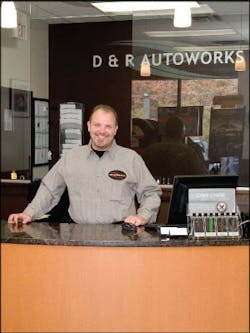Dan Buss is careful, meticulous even, when it comes to running his business. He plans; he researches; he seeks training; he religiously analyzes the numbers; he does everything he can to put his shop in a position to succeed.
“I’ve just never wanted to leave anything out there, anything I could’ve done to make the shop better,” says Buss, owner of D&R Auto Works in Highland Park, Ill.
And that’s why, in early 2012, Buss started looking hard at his facility.
In his 18 years at D&R Auto Works (first as the general manager, then as a partner, and now as the sole owner), Buss guided the business from its humble beginnings as a $350,000-a-year gas station shop to a standalone $2.4 million business.
But, the shop was in a leased building.
“It was really the only thing we didn’t have full control over,” Buss says, “and I wanted to fix that. So, I really made a push to buy it.”
—Dan Buss, owner, D&R Auto Works
And the landlord agreed to sell—but not to Buss. The building was sold to a local dealership that offered nearly double what Buss had it appraised for.
With his business thriving and firmly cemented as a staple of the Highland Park community, D&R Auto Works was now facing an uncertain future.
“I’d be lying if I said I wasn’t worried. … You work so hard to build this business—so many of our people have worked so hard to do it—and now you have no idea what’s going to happen,” Buss says.
The Backstory
When Buss started out as a 25-year-old general manager at D&R in 1994, the shop was churning out oil changes and brake jobs from a couple of small gas station bays in downtown Highland Park.
By 1998, the shop was just shy of $1 million in sales and Buss became a full-on partner in the business, helping it move into an 8,000-square-foot, standalone facility in a more affluent area of Highland Park.
“We joke that it’s the ‘mini-Beverly Hills’ of Illinois,” Buss says. “Once we got there, I wanted to really focus on the demographics in our area.”
So, he pivoted the shop’s business model. He began training, educating and equipping his staff to work on all high-end European and Asian model vehicles. They also kept doing domestic work and soon became recognized as the premier shop in the area.
Buss bought out his partner in 2004 and during the last eight years doubled the shop’s annual revenue, reaching an all-time high of $2.4 million in 2012.
The Problem
Buss likes his shop’s current location: It’s in a nice part of town, near busy roads with relatively easy access for customers.
But was it worth $2.2 million for him to stay there?
“Honestly, it just wasn’t,” he says. “[The dealership] offered a price that we weren’t willing to pay, a price that the building was not worth. That price ($2.2 million) was over a million dollars more than we had it [appraised] at.”
The situation rattled Buss—he was the one who initiated talks of a sale with his landlord. He was offered the opportunity to match any price, but he chose not to.
In the midst of all of its success, Buss’s business had until mid-2014 to move out.
The Options
Buss didn’t want to be stuck under the power of a landlord ever again, so leasing another facility was not going to happen, he says. He needed to find a property to buy.
“We literally scoured the area,” he says. “With what was available in town, there just weren’t a lot of options.
“We wanted a facility that would allow us to keep growing. We wanted more space, not less, and that made it really tough.”
Buss enlisted the help of a real estate specialist who, literally, went door to door around town asking if anyone was willing to sell.
This gave Buss a couple of choices: There was an old space downtown previously used by a dealership, and there was a cluster of small businesses in a facility on the outskirts of town, a “great location on great roads” but a building that would need to be torn down and rebuilt to fit his needs.
The latter was the more enticing option, but the price to build the facility Buss wanted was roughly $2.4 million.
The Decision
Although his shop had roughly two years to move out (the contract with the dealer was signed in February of 2012, and Buss had until March of 2014 to be out), Buss knew he had to move quickly to make the transition as smooth as possible.
The Experts Weigh In
Jeff Laney, president, International Automotive Resources LLC
Some things really stand out about Dan Buss. His careful, meticulous planning is paying off. He researches, seeks training, religiously analyzes and the results are impressive. His strategic location and upper-end training have a lot to do with his profits and growth but it is something else that saw him through a potentially disastrous situation … He “always saved money” and “always made sure to own the equipment.” Shop owners that live beyond their means set themselves up for failure at the slightest mishap, but Buss was ready for trouble and turned it into an even more profitable arrangement. I have to chime in with him and agree: “Situations are what you make of them.”
Scott “Gonzo” Weaver, shop owner, author
Taking the punches from the daily running of a repair shop is no different than dealing with the issues of most other types of businesses. Looks to me as the situation was handled as best as could be done with what they had to work with.
Each situation is going to be slightly different. The thing to keep in mind is that “not” doing anything or thinking the problems will pass by without being a problem … is a problem. Confronting changes and moving forward is what any businessperson has to do to succeed. Standing around waiting for change to happen isn’t going to make you any money. Be proactive.
“Basically, it came down to the decision that if we were going to buy something and commit to a building for our long-term future, I wanted it to be exactly what we wanted,” he says.
The old dealer shop wasn’t going to do that, he says.
In October of 2012, Buss reached an agreement to buy the other property, which was located on a corner lot in a “more commercial area” of town.
While the cost of purchasing the property and building the new facility would exceed that of buying out his previous one, Buss says it would be worth the difference: “Really, I’m getting almost exactly what I would want in a facility, one that will be worth the money I’m paying for it,” he says. The neighborhood, the roads and the demographics are ideal for his business, he says, and building the facility from scratch allows him to create the exact building to fit his business’s needs.
He took control of the property in December, bulldozed the existing buildings and broke ground in January.
The Aftermath
Buss still has some time before his business will begin working out of the new facility (he’s looking at an early summer opening), but he already started the process of transitioning the shop.
He launched a heavy marketing campaign to make current customers aware of the change, doing everything from mailers to emails to simply discussing it with them when they were in the shop.
The new building will be much larger at 16 bays and 14,000 square feet. He has already begun looking into hiring more staff and he has started creating new procedures that will better suit the new facility. For example, he’s designing a new workflow system to get vehicles in and out of the shop and a new test-drive procedure to match the area roads.
Buss expects the larger, more efficient facility, coupled with its improved location, to generate solid growth.
The Takeaway
Buss says a lot ran through his head when he found out his shop would be losing its facility.
“I mean, it’s not easy to hear,” he says. “And you have to realize that you have 15 employees that count on you to feed their families. You have to realize that, no matter what, you have that responsibility to find a solution. You have to find a way to make things work and continue to grow.”
Buss says the biggest lesson he learned through the process was how careful planning and managing of his shop paid off.
“We’ve always saved money, we’ve always made sure to own the equipment we buy and not get tied up in loan after loan,” he says. “People always say you need a savings account for a ‘rainy day.’ Well, losing your facility is a pretty big rainy day, and we were prepared to handle it.”
That lesson, Buss says, extends far beyond his shop’s circumstances.
“Look at the last five years: We’ve been in a recession, and these have been the best five years our shop has ever had,” he says. “Situations are what you make of them. If you realize your situation, market yourself appropriately and make the right adjustments, you can grow no matter what.”
About the Author

Bryce Evans
Bryce Evans is the vice president of content at 10 Missions Media, overseeing an award-winning team that produces FenderBender, Ratchet+Wrench and NOLN.
